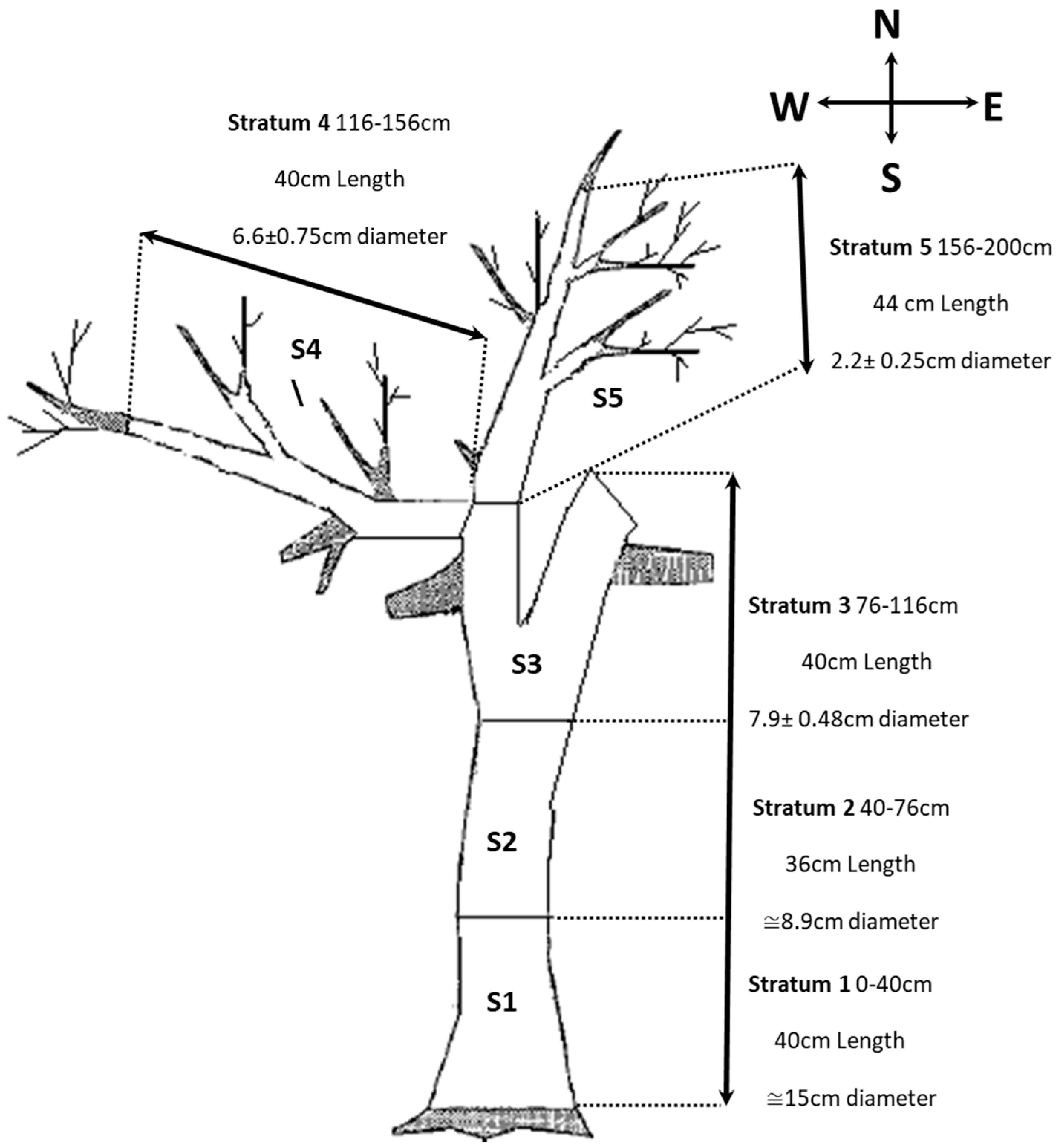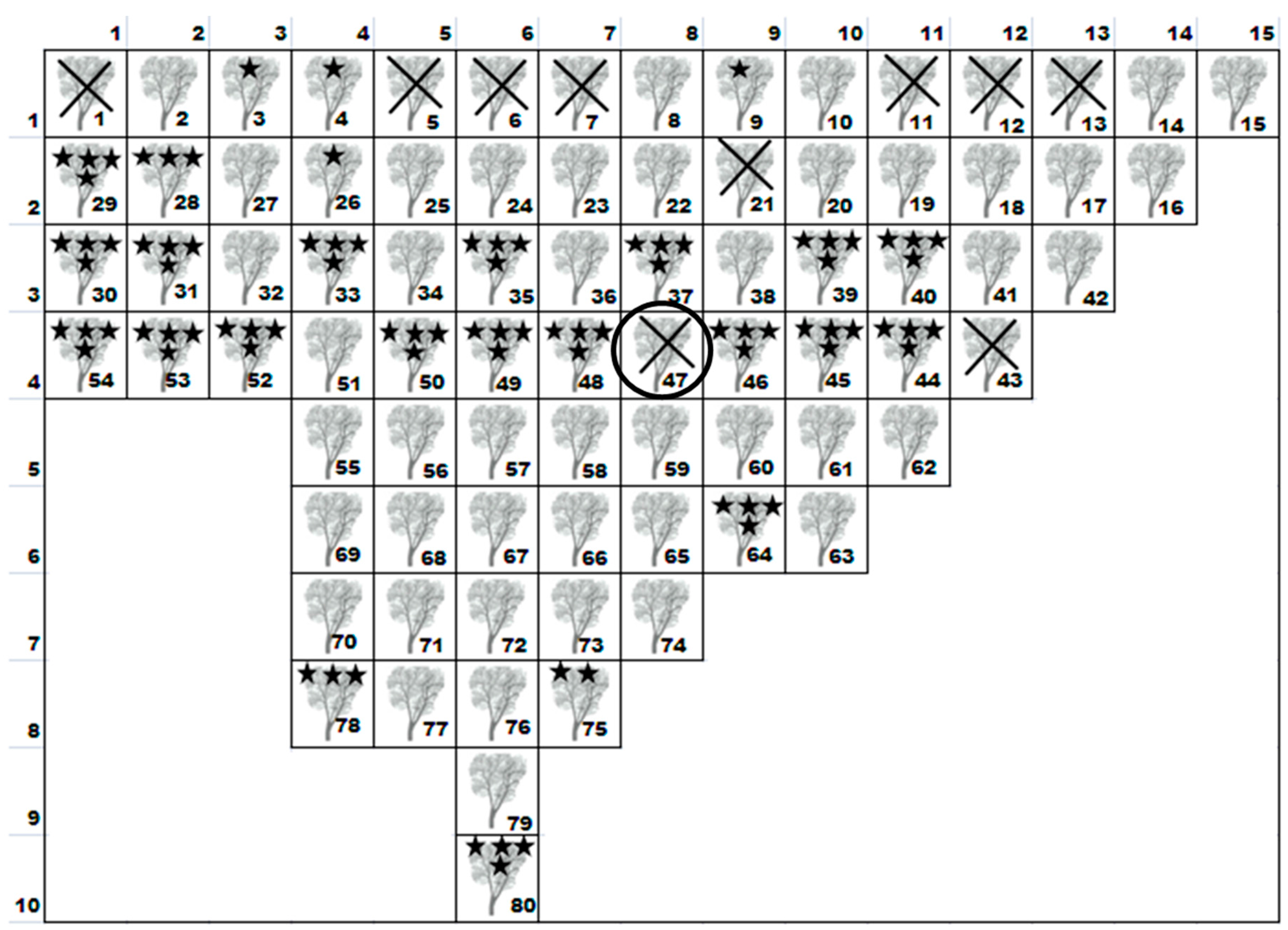Monitoring the Attack Incidences and Damage Caused by the Almond Bark Beetle, Scolytus amygdali, in Almond Orchards
Abstract
:1. Introduction
2. Materials and Methods
2.1. Sampling Survey of S. amygdali Attack on an Almond Tree
2.2. Survey of Almond Trees to Assess Scolytus amygdali Abundance/Density
2.3. Data Analysis
3. Results
3.1. Distribution of Scolytus amygdali Attack Abundance on a Tree
3.2. Survey of Almond Trees to Assess the Abundance of Scolytus amygdali Populations
4. Discussion
Supplementary Materials
Acknowledgments
Author Contributions
Conflicts of Interest
References and Note
- Ministry of Agriculture and Hydraulic Resources 2006–2007. Accessed in 2014.
- Bahri, S. Lipolytic activity and chilling requirement for germination of some almond cultivars. Afr. J. Biotechnol. 2012, 11, 14096–14101. [Google Scholar] [CrossRef]
- Food and Agriculture Organization of the United Nations, Statistics Division, FAOSTAT [Production/Crops for Almonds with Shell (Database 2014)]. Available online: http://www.fao.org/faostat/en/#data/QC (accessed on 26 November 2017).
- Cherif, R.; Trigui, A. Ruguloscolytus amygdali Guerin [Scolytus amygdali], scolytid of fruit trees in the mid-southern regions of Tunisia. Ann. Inst. Nat. Rech. Agr. Tun. 1990, 63, 12. (In French) [Google Scholar]
- Zeiri, A. Bio-Ecology of the Almond Bark Beetle Scolytus amygdali (Coleoptera: Curculionidae: Scolytinae) in the Coastal Region of Tunisia. Identification of Natural Enemies. Ph.D. Thesis, Faculty of Sciences of Bizerte, University of Carthage, Carthage, Tunisia, 2015. (In French). [Google Scholar]
- Mendel, Z.; Ben Yehuda, S.; Marcus, R.; Nestel, D. Distribution and extent of damage by Scolytus spp. to stone and pome fruit orchards in Israel. Insect Sci. Appl. 1997, 17, 175–181. [Google Scholar] [CrossRef]
- Picard, F. Sur deux scolytes des arbres fruitiers et leurs parasites. Bull. Pathol. Veg. Fr. 1921, 8, 16–19. (In French) [Google Scholar]
- Russo, G. Contributo alla conoscenza degli Scolytidi II. Lo scolitide del mandorlo: Scolytus amygdali (Guèr.). Note biologiche. Boll. Lab. Zool. Gen. Agrar. R. Ist. Super. Agric. Portici 1931, 25, 327–349. (In Italian) [Google Scholar]
- Kinawy, M.M.; Tadors, A.W.; Abdallah, F.F. On the biology of the shot-hole bark beetle Scolytus amygdali Guer. (Coleoptera: Scolytidae) on pear trees in Egypt. Bull. Fac. Agric. Univ. Cairo 1991, 42, 119–128. [Google Scholar]
- Buhroo, A.A.; Lakatos, F. On the biology of the bark beetle Scolytus nitidus Sched (Coleoptera: scolytidae) attacking apple orchards. Acta Silv. Lignaria Hung. 2007, 3, 65–74. [Google Scholar]
- Benazoun, A. Etude Bioécologique sur les Scolytes de L’amandier Ruguloscolytus amygdali GUERIN (Col, Scolytidae) au Maroc. Thèse de Doctorat, d’état en Sciences Naturelles, University Paris VI, Paris, France, 1983. (In French). [Google Scholar]
- Batta, Y.A. Biocontrol of almond bark beetles with Beauveria bassiana among the spruce bark beetle, Ips typographus (Coleoptera: Scolytidae) in the laboratory and under field conditions. J. Appl. Microbiol. 2007, 103, 1406–1414. [Google Scholar] [CrossRef] [PubMed]
- Benazoun, A.; Schvester, D. Essai de traitement chimique à la Deltamethrine sur Amandier contre Scolytus (Ruguloscolytus) amygdali (Guer.). Actes Inst. Agron. Vét. 1989, 9, 25–30. (In French) [Google Scholar]
- Ben-Yehuda, S.; Tolasch, T.; Francke, W.; Gries, R.; Dunkelbum, E.; Mendel, Z. Aggregation pheromones of almond bark beetle Scolytus amygdali (Coleoptera: Scolytidae). IOBC-WPRS Bull. 2002, 25, 1–12. [Google Scholar]
- Benazoun, A. Répartition des attaques de R. amygdali GUERIN (Coleoptera Scolytidae) sur amandier dans la région de Tafraout. Actes. Inst. Agron. Vét. 2004, 24, 35–44. (In French) [Google Scholar]
- Mohamed, M. Le Climat Agricole au Sahel Tunisien et les Changements Climatiques. Mémoire. La Thèse de Master, Université du Québec à Montréal, Montréal, QC, Canada, 2009; 147p. (In French). [Google Scholar]
- Zeiri, A.; Braham, M.; Braham, M. The effects of Climatic Variability and Change on the activity of the Almond bark beetle Scolytus amygdali in the coastal zone of Mahdia. In Revue des Régions Arides—Numéro Spécial—n° 35 (3/2014), Proceedings of the Actes du 4ème Meeting International Aridoculture et Cultures Oasisennes: Gestion des Ressources et Applications Biotechnologiques en Aridoculture et Cultures Sahariennes: Perspectives Pour un Développement Durable des Zones Arides, 17–19 December 2013; Institut des Régions Arides (IRA): Medenine, Tunisia, 2013. [Google Scholar]
- Svihra, P. An unusual attack pattern of Scolytus multistriatus beetles in Chinese Elm. J. Arboric. 1998, 24, 322–332. [Google Scholar]
- Talbi, Y. Contribution à l’Étude des Insectes Associés au Dépérissement du Cèdre de l’Atlas (Cedrus atlantica M.) dans la Région de Batna: Cas de la Cedraie de Belezma. Master’s Thesis, Diplôme de Magistère en Science Agronomique, Université El Hadj Lakhdar, Batna, Algeria, 2010. (In French). [Google Scholar]
- Chararas, C. Encyclopédie Entomologique “les Scolytides des Conifers”; Lechevalier, P., Ed.; P. Lechevalier: Paris, France, 1962; p. 536. (In French) [Google Scholar]
- Mahhou, A.; Dannis, F.G. The Almond in Morocco. HortTechnology 1992, 2, 488–492. [Google Scholar]


| Strata | Orientations | Percent Attack Number (Total) | Percent Attack Density (Total) | Percent Multiplication Rate (Total) | Pearson Chi-Square |
|---|---|---|---|---|---|
| Stratum S1 | North | 22.89 (83) | 25.00 (0.04) | 08.30 (44) | X2 = 0.99, df = 6, p = 0.369 |
| South | 25.30 (83) | 25.00 (0.04) | 36.92 (44) | ||
| East | 20.48 (83) | 25.00 (0.04) | 13.06 (44) | ||
| West | 31.32 (83) | 25.00 (0.04) | 41.70 (44) | ||
| Total | 18.95 (438) | 7.02 (0.57) | 12.19 (358) | ||
| Stratum S2 | North | 27.27 (110) | 27.27 (0.11) | 22.75 (72) | X2 = 0.99, df = 6, p = 0.040 |
| South | 20.90 (110) | 18.18 (0.11) | 4.069 (72) | ||
| East | 23.63 (110) | 18.18 (0.11) | 37.58 (72) | ||
| West | 28.18 (110) | 36.36 (0.11) | 35.58 (72) | ||
| Total | 25.11 (438) | 19.30 (0.57) | 19.94 (358) | ||
| Stratum S3 | North | 26.00 (100) | 20.00 (0.1) | 27.88 (97) | X2 = 0.99, df = 6, p = 0.062 |
| South | 14.00 (100) | 20.00 (0.1) | 32.61 (97) | ||
| East | 30.00 (100) | 30.00 (0.1) | 19.92 (97) | ||
| West | 30.00 (100) | 30.00 (0.1) | 19.57 (97) | ||
| Total | 22.83 (438) | 17.54 (0.57) | 26.87 (358) | ||
| Stratum S4 | North | 13.41 (82) | 10.00 (0.1) | 27.48 (85) | X2 = 0.99, df = 6, p = 0.147 |
| South | 32.92 (82) | 40.00 (0.1) | 18.47 (85) | ||
| East | 29.26 (82) | 30.00 (0.1) | 25.097 (85) | ||
| West | 24.39 (82) | 20.00 (0.1) | 28.94 (85) | ||
| Total | 18.72 (438) | 17.54 (0.57) | 23.70 (358) | ||
| Strataum S5 | North | 28.57 (63) | 27.27 (0.22) | 24.38 (62) | X2 = 0.99, df = 6, p = 0.497 |
| South | 23.80 (63) | 22.72 (0.22) | 13.44 (62) | ||
| East | 23.80 (63) | 22.72 (0.22) | 20.97 (62) | ||
| West | 23.80 (63) | 27.27 (0.22) | 41.19 (62) | ||
| Total | 14.38 (438) | 38.59 (0.57) | 17.28 (358) | ||
| Pearson chi-square | X2 = 16.16, df = 12, p = 0.184 | X2 = 3.35, df = 12, p = 0.993 | X2 = 44.67, df = 12, p < 0.001 * | ||
| N | Min. | Max. | Sum | Mean | SD | |
|---|---|---|---|---|---|---|
| Height | 70 | 1.2 | 5.0 | 164 | 2.343 | 0.7876 |
| Circumference | 70 | 24 | 95 | 3952 | 56.45 | 17.913 |
| Gum | Foliar | Flower | Circumference | |
|---|---|---|---|---|
| Attack intensity | 0.312 ** | −0.309 ** | −0.488 ** | 0.315 ** |
| 0.009 | 0.009 | <0.000 | 0.008 |
© 2018 by the authors. Licensee MDPI, Basel, Switzerland. This article is an open access article distributed under the terms and conditions of the Creative Commons Attribution (CC BY) license (http://creativecommons.org/licenses/by/4.0/).
Share and Cite
Zeiri, A.; Ahmed, M.Z.; Cuthbertson, A.G.S.; Braham, M.; Braham, M. Monitoring the Attack Incidences and Damage Caused by the Almond Bark Beetle, Scolytus amygdali, in Almond Orchards. Insects 2018, 9, 1. https://doi.org/10.3390/insects9010001
Zeiri A, Ahmed MZ, Cuthbertson AGS, Braham M, Braham M. Monitoring the Attack Incidences and Damage Caused by the Almond Bark Beetle, Scolytus amygdali, in Almond Orchards. Insects. 2018; 9(1):1. https://doi.org/10.3390/insects9010001
Chicago/Turabian StyleZeiri, Asma, Muhammad Z. Ahmed, Andrew G. S. Cuthbertson, Mohamed Braham, and Mohamed Braham. 2018. "Monitoring the Attack Incidences and Damage Caused by the Almond Bark Beetle, Scolytus amygdali, in Almond Orchards" Insects 9, no. 1: 1. https://doi.org/10.3390/insects9010001




